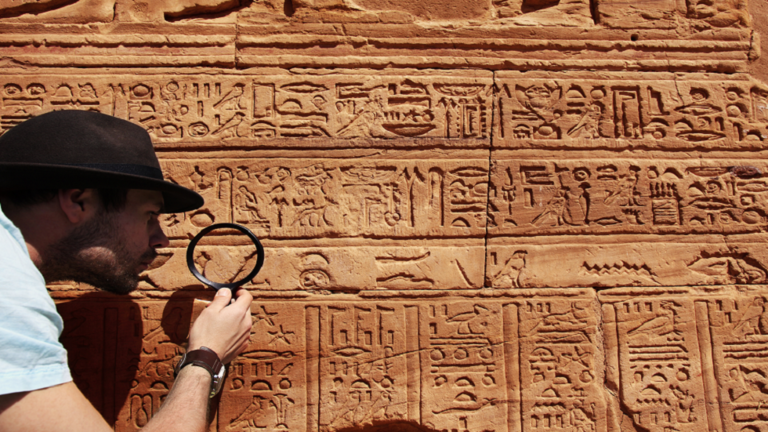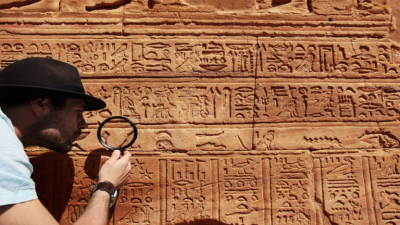From mummies with golden tongues to a pyramid designed for a previously unknown queen, here are 10 astounding discoveries about ancient Egypt from 2022. Ancient Egypt conceals many secrets, and in 2022, archaeologists made several remarkable discoveries, including the tomb of an unknown queen, a shrine for falcons with a mysterious message, and a massive tunnel beneath a temple. Below are some of the most astonishing discoveries at ancient Egyptian archaeological sites this year.
1. **Vivid Mummy Portraits**
While excavating a tomb in the ancient city of Philadelphia, archaeologists uncovered two complete mummy portraits, along with several incomplete images of individuals buried in the tomb. Researchers believe those interred were likely from the middle class or elite, as commissioning portraits of their likenesses was expensive. Due to looting, such mummy portraits are exceedingly rare, with the last recorded examples found in the 1880s.
2. **Temple Dedicated to Zeus Cassius**
At the site of Tel el-Farama in the Sinai Peninsula, archaeologists discovered the remains of a temple dedicated to Zeus Cassius, a deity believed to be a combination of Zeus and the weather god Cassius. The researchers identified the temple after noticing sections of two columns made of pink granite protruding from the ground, which likely supported the temple's front gate and may have collapsed in ancient times during a massive earthquake.
3. **Mummies with Golden Tongues**
During the Greco-Roman period, it was not uncommon for mummies to be buried with golden tongues. The ancient Egyptians believed that this would help transform the deceased into divine beings in the afterlife. A team of archaeologists found several examples of this burial practice at a dig site in an ancient cemetery near Quesna, north of Cairo. The burials also contained a significant number of funerary goods, such as necklaces and pottery.
4. **Falcon Shrine and Mysterious Message about Boiling Heads**
Archaeologists discovered a 1,700-year-old shrine containing 15 decapitated falcons on a base, alongside a stone monument depicting unknown deities in the port of Berenike on the Red Sea. An iron spear was found next to the statue's base, but what truly astonished researchers was the Greek inscription they noted in one of the shrine's back rooms, which read, "It is inappropriate to boil the head here."
5. **Gold Ring Depicting "The God of Merriment"**
While exploring a burial site in Akhetaten (modern-day Amarna), south of Cairo, archaeologists unearthed a hidden treasure of gold artifacts, including a necklace and three rings. One piece of jewelry stood out for its engraving of Bes, "the God of Merriment." Ancient depictions of the jovial deity can be found throughout Egypt.
6. **Protective Tattoos during Childbirth**
Before giving birth, some ancient Egyptian women would get tattoos as a form of protection during childbirth. Archaeologists discovered six examples of this practice while studying mummies buried in Deir el-Medina, an archaeological site located on the banks of the Nile. Finding ancient tattoos is extremely rare, as skin needs proper preservation. However, in this case, parts of the corpses were revealed, including the lower back of a woman that featured old ink in black lines depicting the deity that protected women during childbirth.
7. **Extensive Water Tunnel**
Archaeologists have discovered a tunnel measuring 4,281 feet (1,305 meters) beneath a temple in Taposiris Magna, an ancient city located west of Alexandria, Egypt. It is believed that at one time, this massive tunnel was used to transport water to citizens, and it is a replica of the Eupalinos tunnel on the Greek island of Samos, which is considered an engineering marvel.
8. **Birds in a "Masterpiece" of Egypt**
A detailed panel featuring birds flying and standing beside a marsh was so intricately crafted that contemporary researchers used a replica to identify the exact species depicted in the 3,300-year-old artwork. Archaeologists found the "masterpiece" a century ago on the walls of a palace in the ancient Egyptian capital of Amarna, but researchers only recently recognized the species portrayed in the artwork, including the kingfisher (Ceryle rudis).
9. **New Understanding of Mummification**
Archaeologists have overturned what is typically taught in schools regarding mummification. The ancient Egyptians used the burial practice not merely to preserve the bodies of the dead but as a means to guide them toward divinity. The new understanding, which archaeologists call "180 complete," is the centerpiece of an exhibit titled "The Golden Mummies of Egypt," which opened in early 2023 at the Manchester Museum at the University of Manchester, England.
10. **Tomb of an Unknown Queen**
On the centenary of the discovery of King Tutankhamun's tomb, a group of archaeologists uncovered the tomb of a previously unknown queen: Queen Nith. The discovery was made in Saqqara, an archaeological site in Giza, marking her first mention in the archaeological record. Besides the tomb, researchers found several coffins and mummies, some belonging to the closest generals and advisors of King Tut.




